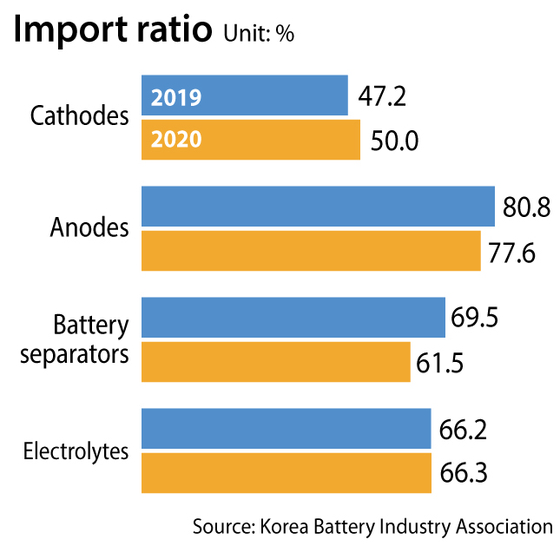Charging EVs needs to be 'as fast as pumping gas'

The make-or-break for electric vehicles (EV) often comes down do the most mundane of metrics: charging time.
Kim Kyung-min, a 49-year-old who owns a mid-sized passenger vehicle, has been considering the purchase of an EV. Tax incentives and the fact that the cars are eco-friendly made them attractive. But he eventually chose to buy a hybrid SUV, which utilizes power from both electricity and fuel.
“I would have chosen an EV if charging electric cars was as fast as pumping gas,” said Kim.
Companies are moving fast to minimize EV battery charging times. After focusing on cathodes to increase the energy density of lithium-ion batteries, extending the maximum distance an EV can travel when a battery is fully charged, battery makers are shifting focus to anode materials to offer fast charging. Anodes absorb lithium ions when the battery is charging, and are crucial to shortening charging time.
Posco Chemical has been increasing production of artificial graphite anodes, which is most often used for lithium ion batteries.
“Artificial graphite anodes are high in stability and have high battery efficiency due to faster absorption of lithium ions, but are expensive to produce,” said Lee Yo-han, a communication team leader at Posco Chemical. “We’re conducting research to lower production costs.”
Almost all graphite in Korea is imported from China, and Posco Chemical aims to cut the company’s dependency on China to about 50 percent. The company invested 217.7 billion won ($184 million) in building an artificial graphite anode material factory in Pohang, South Gyeongsang last year, aiming to complete construction by 2023. The chemical manufacturer expects the factory to produce 16,000 tons of artificial graphite every year.
According to the Korea Battery Industry Association, Korea imported 77.6 percent of its anode supply last year, and local production was only 8.3 percent of total global production.
The chemical maker acquired for $7.5 million a 15 percent stake in Perth, Australia’s Black Rock Mining in January, getting access to graphite from a Mahenge graphite mine in Tanzania. The mine has around 83 million tons of graphite reserves.
“To increase local production of key K-battery components, we urgently need to provide support such as tax incentives, financial support, aid for research and development and personnel training,” said Rep. Kim Kyung-man of the ruling democratic party on Oct. 14.
Some companies are concentrating on utilizing silicon anodes, which are known to reduce EV battery charging times by three to four times compared to batteries with graphite.
LG Energy Solution partnered with Siheung, Gyeonggi-based silicon anode provider Daejoo Electronic Materials in 2019, supplying silicon anode batteries to Porsche’s Taycan starting that year. The batteries have 5 percent silicon-based anodes, which propel EVs up to 100 kilometers (62 miles) for five minutes of charging. The companies are jointly conducting research to further raise silicon anode content to 7 percent.
SK Innovation’s SK On is currently developing 5-percent silicon anodes.
“We’re using graphite anodes in our batteries, but are conducting tests and research on silicon-anode batteries since they are more efficient,” said Kim Woo-kyung, a public relations team lead at SK Innovation’s Value Creation Center. “Silicon is expensive, and cost-efficient production is key.”
SK Materials, 49.1 percent owned by SK Holdings, established a joint venture with Woodinville, Washington’s Group14 Technologies in July. The companies plan to build an EV materials plant in Sangju, North Gyeongsang. Some 550 billion won will be used to build a silicon anode factory and 300 billion won to build a plant that products silane, a raw material used for silicon anodes, by 2022.
Samsung SDI in September started the production of Gen5 silicon anode EV batteries, which will be later used on BMW’s EVs.
“Companies are overall working to produce 5-percent silicon anodes, but the percentage composition will increase because efficiency rises as the amount of silicon increases,” said Song Chi-heoun, a communication team lead at Samsung SDI.
Market tracker SNE Research announced that the silicon anode market will rise to 200,000 tons in 2030, from 4,000 tons this year.
Demand for silicon-based materials will rise, but weaknesses exist.
“There could be problems because silicon tends to swell depending on external conditions and easily run out of energy when charged several times,” said Sun Yang-kook, a professor teaching energy and engineering at Hanyang University. “We need to overcome these technical limitations.”
BY MOON BYUNG-JOO, LEE TAE-HEE [lee.taehee2@joongang.co.kr]










with the Korea JoongAng Daily
To write comments, please log in to one of the accounts.
Standards Board Policy (0/250자)